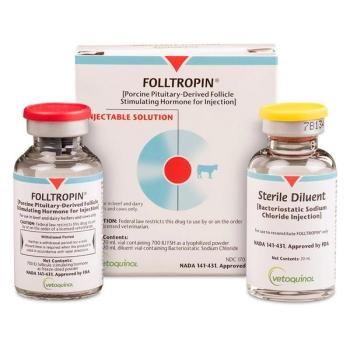
Targeting antimicrobials in food animals (part 1) (Proceedings)
This checklist serves as a starting point for evaluating your applications of antimicrobials in food animals.
This checklist serves as a starting point for evaluating your applications of antimicrobials in food animals.
1. Do I understand the difference that will be made in clinical outcome from my application of a drug to this animal or in this system?
• See Number Needed to Treat below
• How much of the observed clinical response rate is due to the drug and how much is due to spontaneous recovery?
• Is appropriate clinical trial data available to drive my decision process?
o Prospective?
o Randomized?
o Masked?
o Controlled?
o Appropriate statistical treatment?
o Applicable to this production system?
1. Animal type and production stage
2. Case definitions for illness and success/failure
• Are the trial outcome parameters an actual clinical response or a substitution variable?
o Fever reduction vs. change in clinical outcome
o Titers vs. disease protection
• How can I address my observational bias in interpreting the outcome of drug applications in production systems?
o Historical controls?
o True case success and case fatality rates?
2. For antimicrobials, do I understand the application of antimicrobial susceptibility testing?
• Clinical and Laboratory Standards Institute (CLSI) approved breakpoints
• Correct methods for in-house testing
• Kirby-Bauer vs. microwell dilution methods
3. Is it legal?
• AMDUCA regulations
o Prohibited ELDU drugs
o Avoidance of illegal residues
• Compliance policy guideline for compounding
4. Have I thought through the disposition of animals after receiving this drug?
• Withdrawal time or extended withdrawal time?
• Are they able to enter the food chain in any manner?
5. Could there be untoward food safety effects?
• Residues?
• Antimicrobial effects on prevalence or susceptibility of foodborne pathogens?
6. Have I actually searched for and considered evidence?
• Am I being authoritarian or authoritative?
Challenges in daily practice require a decision. If decisions are only made in the light of clear, well documented evidence, then paralysis often results. If decisions are usually made based on selective memory and the most recent technology, then the title of wizard applies. Practicing between these two extremes requires knowing what the complete body of evidence is, which evidence is sufficiently valid to consider, and how this evidence applies to your practice situation. This is a description of evidence-based medicine.
As we struggle to put research data into a format that we can use, and that we can explain to our clients, perhaps the concepts of Attributable Risk Reduction (ARR) and Number Needed to Treat (NNT) are useful.
Attributable risk reduction(ARR) refers to the decrease in risk of an adverse event that is due to a treatment. The adverse event may be treatment failure or mortality in the case of therapy or occurrence of a clinical case when a preventive treatment has been applied to a group. It is expressed as the actual % difference in response between the treated and control groups.
Number need to treat (NNT) refers to the number of animals to which the treatment must be applied to result in an outcome difference for one animal. It is calculated from the ARR as in the example below.
Example: An antimicrobial treatment is individually applied to cattle for treatment of footrot in a study where another group of cattle received no treatment for the same clinical presentation. The cows were randomly assigned to treatment, cow is the experimental unit, and subjective evaluators of treatment outcome were masked to treatment. A clinical success rate of 25% was noted for the untreated control cattle and 75% for the treated cattle. The failure rates would therefore be 75% for the controls and 25% for the treated group. The ARR is calculated determining the difference in the rates (same difference between failure and success rates). In this case, the ARR is 50%.
To determine the NNT, divide the ARR % value into 100%. In this example, the NNT would be 2. When presented these values, you would know from the ARR that there was an actual 50% difference between the failure or success rates. The NNT value converts these to how many cattle would need to be treated to make a difference in one animal.
A more intuitive way of looking at the numbers involves looking at how many success or failures would be present in common in both treatment groups. Since 1 in 4 cattle would be a failure (25%) and 1 in 4 cattle would be a success (25%) regardless of treatment, that leaves 2 out of 4 cattle where the treatment makes a difference. This is equivalent to 1 out of 2 cattle, meaning we have to treat 2 cows to see a difference in one cow.
So, where can you get this kind of information?
For more recently approved drugs, you can access the label summary at the "Animal Drugs @ FDA" site:
Or, search for published literature on PubMed. http://www.ncbi.nlm.nih.gov/sites/ entrez?otool=kssulib&dr=citation entrez?otool=kssulib&dr=citation At this site you can search by keyword for articles and then select articles for which you want to view the abstract. We can get into trouble just reviewing abstracts where we cannot evaluate the critical study components. However, you should be able to link to very important articles and purchase copies, or hit up a university faculty member or your alma mater veterinary school library for assistance in obtaining the paper.
Let's use an example of searching for evidence of what happens when we put a systemic antimicrobial in cows with coliform mastitis. These would need to be prospective, randomized, controlled (contemporaneous negative controls), and masked (blinded) studies.
I went on PubMed on 5/3/2010 and searched for these terms: mastitis and coliform and (bovine or cow or cattle or heifer). The first hit was 268 articles. You could scroll through all these titles, but I wanted to narrow it down more. So, I added the term and therapy. Now I was down to 104 articles. The 17th article was this one, which fit the bill for almost all of my search criteria.
The 17th article: Erskine RJ Bartlett PC, VanLente JL, Phipps CR. Efficacy of systemic ceftiofur as a therapy for severe clinical mastitis in dairy cattle. J Dairy Sci 10:2571-2575, 2002. This study meets my criteria of randomized (with methods included), prospective, naturally occurring disease, and cases that are applicable to clinical practice (case definitions clearly defined). I could not determine if any masking was used in the study from the publication, but am giving some slack as we are looking at survival rather than more subjective outcomes. Could the lack of masking confound survival also? It could, but I will go forward with that potential in mind.
The 37th article: Pyoralia SH, Pyoralia EO. Efficacy of parenteral administration of three antimicrobial agents in treatment of clinical mastitis in lactating cows: 487 cases (1989-1995) J Am Vet Med Assoc 2112(3):407-412, 1998. I discarded this article as it was a retrospective, uncontrolled study.
The 39th article: Shpigel NY, et al. Efficacy of cefquinome for treatment of cows with mastitis experimentally induced using Escherichia coli. J. Dairy Sci 80:318-232, 1997. I discarded this article because I am looking for studies with naturally occurring disease and am unsure how this study would apply to clinical cases.
The 57th article: Jones GF, Ward GE. Evaluation of systemic administration of gentamicin for treatment of coliform mastitis in cows. J Am Vet Med Assoc 197:731-735, 1990. This is not a treatment I would use due to withdrawal considerations in cattle, but could there be some guidance as to the actual difference an antimicrobial might make? The article was old enough I would have to go to additional trouble to find it (digging up a hard copy out of the library) so I relied on the abstract to guide me if this would be worth the trouble. First it was a positive control (erythromycin with "resistant" bacteria) for a contemporaneous positive control and the negative control was accomplished in a second phase of the study, making the negative controls (for systemic therapy) non-contemporaneous. For these reasons, I discarded the study.
Evaluation
So, I have one article to consider as evidence (Erskine, et al.) The authors reported that in severe mastitis cases in which the culture yielded coliform organisms, the outcome with the addition of systemic ceftiofur was a mortality rate of 4/29 cows (13.8%) while the standard therapy without systemic ceftiofur resulted in a mortality rate of 10/27 (37%). The difference (ARR) was 23.2 %, giving us an NNT estimate of 4.3 based on this trial, round it to 4. In other words, these data suggest that treating 4 cows with coliform mastitis with systemic ceftiofur would change the mortality outcome of one of the cows, or 23 cows out of a hundred treated. Return to production of surviving cows is obviously another issue. And, I only have one study to guide me. But, it at least puts me in the ballpark with a good, commercial production facility protocol that can be evaluated as to clinical application.
Could another antimicrobial perform differently? Absolutely yes. Would I anticipate it shifting the NNT clear down to 2? It would have to really be an impressive antimicrobial to do that since many of the deaths are likely not due to continued bacterial growth after the time of therapeutic intervention in a commercial setting (toxin production effects after peak growth of bacteria as related to septicemia itself). Could another antimicrobial be significantly worse? Yes. This study gives us a benchmark for a reasonable antimicrobial choice in a clinical setting, and is an excellent example of a good research project for which we need replication with additional studies to increase the confidence of our outcome projections.
Newsletter
From exam room tips to practice management insights, get trusted veterinary news delivered straight to your inbox—subscribe to dvm360.






